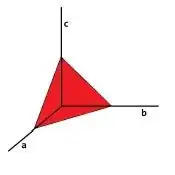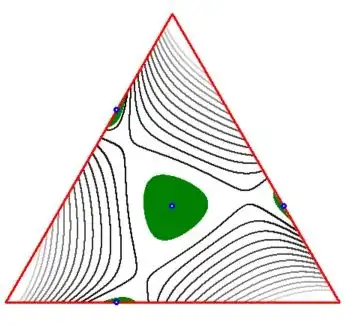Let $a,b,c$ be nonnegative real numbers and $a+b+c=3$. Prove the inequality $$ \sqrt{24a^2b+25}+\sqrt{24b^2c+25}+\sqrt{24c^2a+25}\le 21 $$
I have tried to find the solution using classical inequalities, but failed. Any idea?
Let $a,b,c$ be nonnegative real numbers and $a+b+c=3$. Prove the inequality $$ \sqrt{24a^2b+25}+\sqrt{24b^2c+25}+\sqrt{24c^2a+25}\le 21 $$
I have tried to find the solution using classical inequalities, but failed. Any idea?
Proof without words (more like a pictural comment). The following reference gives some clues about the know how to do such a thing:


Define the function to be investigated as: $$ F(a,b,c) = \sqrt{24a^2b+25}+\sqrt{24b^2c+25}+\sqrt{24c^2a+25} - 21 $$ Scanning the inside of the triangle (picture on the left) pixel by pixel (i.e. numerically) reveals that:
minimum = -5.97874499595267E+0000 ; maximum = -1.86093567294196E-0005The exact minimum is at the vertices of the triangle: $F(3,0,0)=F(0,3,0)=F(0,0,3)=-6$ , just beyond reach of the numerics.
for g := 1 to 16 do
begin
level := -sqr(g/8); { level = minus g/8 squared }
More black means closer to the maximum. Of course we already know that:
$$
F(1,1,1) = 0 \; ; \; F(2,1,0) = 0 \; ; \; F(0,2,1) = 0 \; ; \; F(1,0,2) = 0
$$
These places are indicated as $\color{blue}{blue}$ spots in the picture on the right. So there is strong evidence (ipse est NO "rigorous proof") that $0$ is indeed the maximum. My 2 cents worth ..
EDITs. Picture on the right augmented with $\color{green}{green}$ areas where $|F(a,b,c)| < 0.1$ .
If $F(a,b,c)$ is specified for an edge of the equilateral triangle, then we can do some analytical work, though it remains a modest attempt:
$$
f(x) = F(3-x,x,0) = \sqrt{24(3-x)^2x+25}-11
$$
Derivative zero:
$$
f'(x) = \frac{1}{2}24\frac{-2(3-x)x+(3-x)^2}{\sqrt{24(3-x)^2x+25}} = 0
\quad \Longleftrightarrow \quad x\in\{3,1\}
$$
Giving the known minimum $F(0,3,0)$ and the known maximum $F(2,1,0)$ , the only difference being that these are now proven unique, at the triangle's edges.
In order to demonstrate that the problem is "not so easy", let's specify again, for a line through one vertex of the triangle $(3,0,0)$ and the midpoint $(1,1,1)$:
$$
g(x) = F(3-2x,x,x) = \sqrt{24(3-2x)^2x+25}+\sqrt{24x^3+25}+\sqrt{x^2(3-2x)+25}-21
$$
Then we already know that a solution of $g'(x)=0$ is given by $F(1,1,1)=0$. But, if this is fed into MAPLE , then all I've got is a seemingly endless loop:
> solve(diff(g(x),x)=0,x); Warning, computation interrupted
By C-S $$\left(\sum_{cyc}\sqrt{24a^2b+25}\right)^2\leq\sum_{cyc}(24a^2b+25)(a+3b+5c)\sum_{cyc}\frac{1}{a+3b+5c}$$ Thus, it remains to prove that $$\sum_{cyc}(24a^2b+25)(a+3b+5c)\sum_{cyc}\frac{1}{a+3b+5c}\leq441$$ or $$\sum_{cyc}(648a^2b+25(a+b+c)^3)(a+3b+5c)\sum_{cyc}\frac{1}{a+3b+5c}\leq441(a+b+c)^3$$ or $$\sum_{cyc}(20a^6+47a^5b+352a^5c-209a^4b^2+509a^4c^2-275a^3b^3+$$ $$+690a^4bc-556a^3b^2c-143a^3c^2b-435a^2b^2c^2)\geq0.$$ Now, let $a=\min\{a,b,c\}$, $b=a+u$ and $c=a+v$.
Hence, we need to prove that $$4779(u^2-uv+v^2)a^4+27(263u^3-211u^2v+130uv^2+263v^3)a^3+$$ $$+9(365u^4-58u^3v-453u^2v^2+965uv^3+365v^4)a^2+$$ $$+3(173u^5+169u^4v-739u^3v^2+356u^2v^3+1156uv^4+173v^5)a+$$ $$+(u-2v)^2(20u^4+127u^3v+219u^2v^2+93uv^3+5v^4)\geq0,$$ which is obvious.
Done!